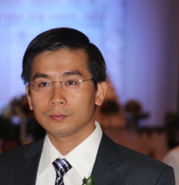
Professor Trung Q. Duong
Affiliation: Memorial University, Canada and Queen’s University Belfast, United Kingdom
Title: 6G Digital Twin: A Joint Computing and Communications Design
Biography:
Dr. Trung Q. Duong (IEEE Fellow and AAIA Fellow) is a Canada Excellence Research Chair and Full Professor at Memorial University, Canada. He is also a Research Chair of the Royal Academy of Engineering and a Chair Professor in Telecommunications at Queen’s University Belfast, UK. His current research interests include quantum optimisation and machine learning in wireless communications. He has published 550+ books/bookchapters/papers with 20,000 citations and h-index 75. He has served as an Editor for many reputable IEEE journals (IEEE Trans on Wireless Communications, IEEE Trans on Communications, IEEE Trans on Vehicular Technology, IEEE Communications Surveys & Tutorials, IEEE Communications Letters, and IEEE Wireless Communications Letters) and has been awarded best paper awards in many flagship conferences including IEEE ICC 2014, IEEE GLOBECOM 2016, 2019, and 2022. He is the recipient of the Research Fellowship (2015-2020) and Research Chair (2020-2025) of the Royal Academy of Engineering. In 2017, he was awarded the Newton Prize from the UK government. He is a Fellow of IEEE and a Fellow of Asia-Pacific Artificial Intelligence Association (AAIA).
Abstract:
It is expected that there will be 100 Billion ‘Internet-of-Things’ devices by the year 2025. Thus, the need for improved wireless reliability and latency is greater than ever. Recent advances in communication technologies and powerful computation platforms open opportunities to implement a wide range of breakthrough applications, especially for time sensitive services in industrial automation. In terms of communication perspective, 6G with ultra-reliable and low latency communications (URLLC) will play a vital role in the development and deployment of mission-critical applications, which require high demands on reliability and low latency communications. This opens opportunities to enable a wide range of new applications such as virtual reality (VR) with a 360-degree view, factory automation, autonomous vehicles, remote healthcare, etc. In addition, the development of digital twin opens new opportunities for transforming the cyber-physical systems in terms of intelligence, efficiency and flexibility. However, there are still many technical issues to be resolved to achieve high reliability and low latency with digital twin and apply this technology in practical scenarios due to the complexity of resource allocation in short packet transmissions. This talk will discuss digital twin technologies in industrial automation that require high data rates with ultra-reliability at very low latency for which URLLC is a natural choice. This talk discusses a joint communications and computation design of URLLC multi-tier computing in 6G that supports digital twin networks, not only fundamental requirements, but also enabling technologies, visions, and future challenges.

